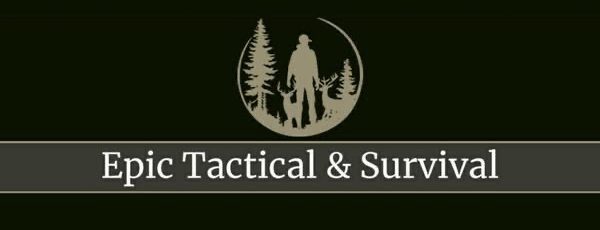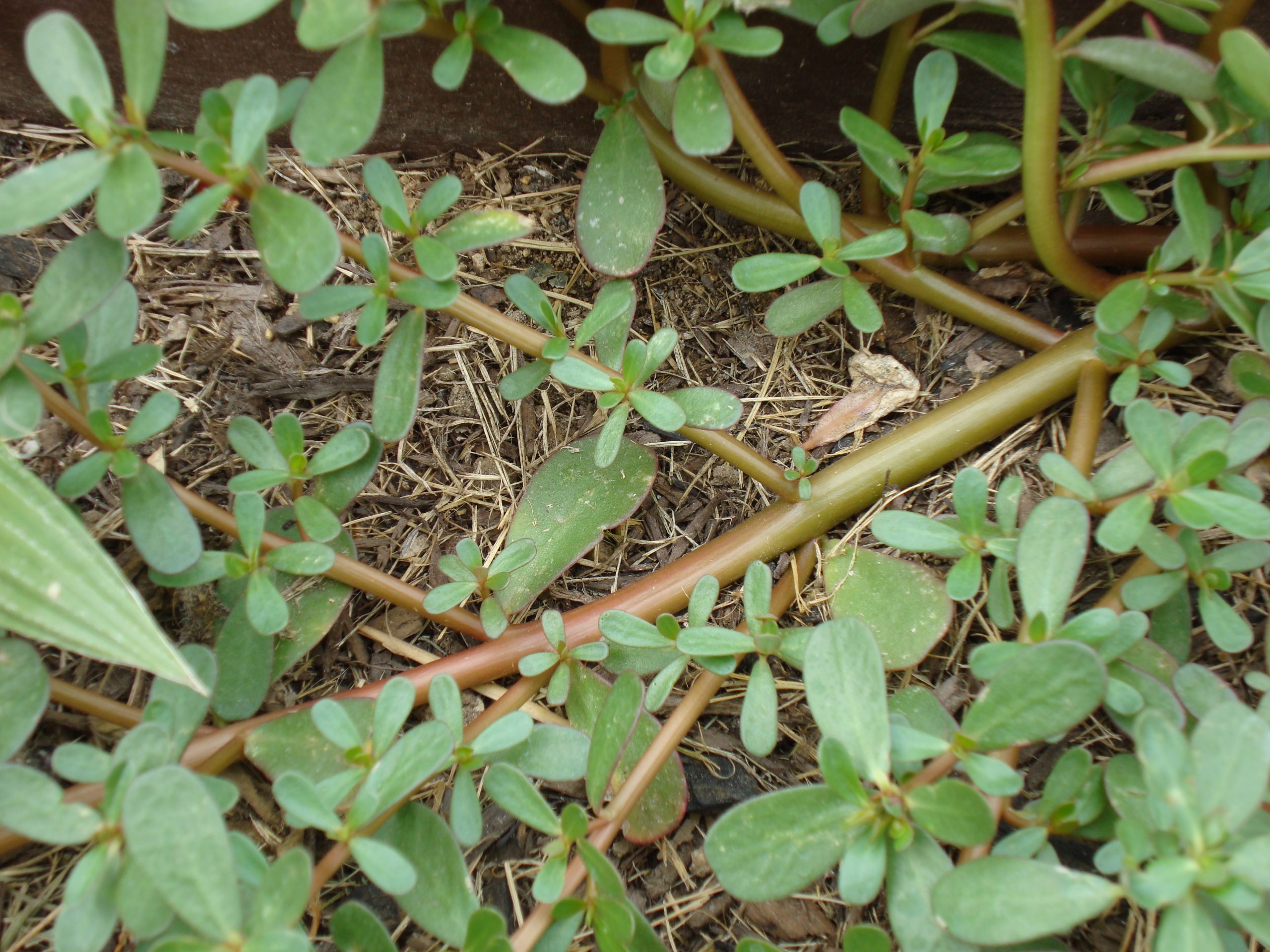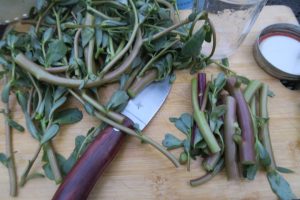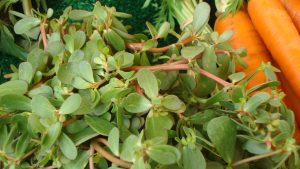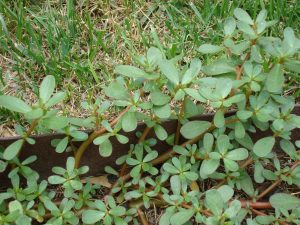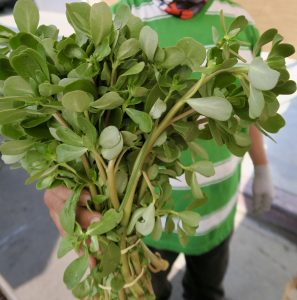(Portulaca oleracea)
By Christopher Nyerges
Remember Henry David Thoreau who wrote “Walden: Life in the Woods”? In the mid 1850s, Thoreau wanted to escape the “over-civilization” that he felt was oppressive, and he wanted to see if he could live life simply with very little. He built a little cabin in the woods outside Concord, Massachusetts, and grew beans and lived simply for over two years.
He wrote, “I learned that a man may use as simple a diet as the animals, and yet retain health and strength. I have made a satisfactory dinner off a dish of purslane which I gathered and boiled. Yet men have come to such a pass that they frequently starve, not from want of necessities, but for want of luxuries.” Indeed, and he observed this in the 1850s!
Purslane is a low-growing succulent annual that starts appearing in your garden in mid-summer, a bit later than most of the common spring greens. It is a very common annual in rose beds and gardens, and it is occasionally seen, en masse, in the sandy bottoms of streams.
The stems are succulent, red colored, and round in the cross section. The stems sprawl outward from the roots, rosette-like, with the stems lying on the ground. The leaves are paddle shaped. The little yellow flower is 5 petaled.
WHERE FOUND:
Though a native of India, this plant is now common and widespread throughout the world. It is found in agricultural lands, swamps, fields, gardens, ditches, and vacant lots. Though it prefers wet soils, it can be found in most environments.
USES:
When you chew on a fresh stem or leaf of purslane, you’ll find it mildly sour and a bit crunchy. It’s really a great snack, though I like it a lot in salads. Just rinse it to get all the dirt off, dice, add some dressing, and serve. Yes, add tomatoes and avocado if you have any.
According to wild food author Mike Krebill, “The tender tips of stems, including leaves, may be eaten raw in salads, baked in quiche, or added to a stir-fry. Flexible stems up to the thickness of a pencil may be pickled.”
If you take the thick stems, clean off the leaves, and cut them into sections of about 4″, you can make purslane pickles. There are many ways to make pickles; my way is to simply fill the jar with the purslane stems, add raw apple cider vinegar, and let it sit for a few weeks. (I refrigerate it.)
Add it to sandwiches, tostadas, even on the edges of your chile rellenos and huevos rancheros. I’ve also eaten it fried, boiled, baked (in egg dishes), and probably other ways, too. It’s versatile, tasty, and crisp. It really goes with anything, and it’s very nutritious.
PROCESSING:
Processing the purslane plant is easy. The entire plant’s stems and leaves and stems are washed, and then used in whatever recipe you’re using.
MEDICINE/NUTRITION:
According to researchers, purslane is one of the richest plant sources of omega-3 fatty acids. In 1986, researcher Norman Salem Jr., a lipid biochemist with the National Institute on Alcohol Abuse and Alcoholism in Bethesda, Maryland, found that purslane was the richest leafy plant source of Omega-3 fatty acids. The omega-3 fatty acids help to reduce the body’s cholesterol levels and reduces the risk of heart attack. That means that not only is it good but it’s also good for you! Salem and his collaborator, Artemis P. Simopoulous with the American Association for World Health in Washington D.C. studied the effects of the eggs from chickens fed wild purslane on a Greek farm. The eggs were found to contain about ten times as much omega-3 fatty acids as you’d find in a typical supermarket egg.
According to the USDA, 100 grams, which is about a half-cup, of raw purslane contains 103 mg. of calcium, 39 mg. of phosphorus, 2,500 mg. of vitamin A, and 25 mg. of vitamin C. It contains smaller amounts of iron, riboflavin, thiamine, and niacin.
ADVICE FOR GROWING: Purslane seeds can be purchased from seed supply companies, and planted in gardens or pots if you don’t have any. The cut stems root easily, so you can cut the thicker stems that you find in the wild, and then simply stick them in good soil in your yard, where they will grow.
CAUTIONS: Sometimes, prostrate spurge is confused for purslane. Prostrate spurge, however, lies very flat to the ground, and when you break the stem of spurge, a white milky sap appears.
Purslane is a member of the Purslane Family, which according to the most recent botanical classification, contains only one genus, Portulaca. There are about 100 species of genus Portulaca world-wide, with Purslane being one of the most common species worldwide. (Formerly, purslane had been classified in the Miner’s Lettuce Family, a family who members are entirely safe to eat.)
RECIPES:
Purslane Salsa
2 cups chopped tomatoes
21⁄2 cups chopped foraged purslane
3⁄4 cup chopped onions
3 garlic cloves
1 cup raw apple cider vinegar
1⁄4 cup sugar
1 large California bay leaf
Salt and pepper to taste
1⁄2 cup chopped cilantro and some herbs from the garden (such as thyme)
Place all ingredients, except cilantro and other herbs, into a pot, bring to a boil, and then simmer to the desired consistency (light or chunky). Add cilantro and other herbs.
Pour into jars, close the lids, and place in the fridge. It should be good for at least a month.
n Recipe provide from Pascal Baudar, author of “Wild Fermentation.”
About the Author:
Nyerges has been teaching ethnobotany since 1974. He is the author of “Guide to Wild Foods and Useful Plants,” “Foraging Wild Edible Plants of North America,” and other books on the uses of wild plants. He can be reached at www.SchoolofSelf-Reliance.com.
